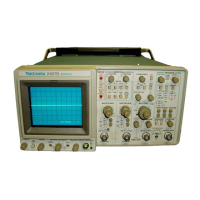Theory of Operation—2465B/2467B Service
Table 3-3
Vertical Display Selection
Select Inputs
VS1
L
H
L
H
H
H
VS2
H
L
L
H
H
H
VS3
H
H
H
L
H
H
VS4
H
H
H
L
L
H
Vertical
Display
CH 1
CH 2
ADD
CH 3
CH4
Readout (Y)
(Readout Vertical) is added to the output whenever both
the VS3 and VS4 select signals are HI but will only contain
readout information when the readout select logic (U975A
and U975C) detects that the Display Sequencer has set
both the Horizontal Select signals ( HSA and HSB ) HI
(readout selected).
READOUT SWITCH/AMPLIFIER. Transistors U485A,
U485B,
U485C, U485D, and U475C, along with their
associated components, make up an analog switch circuit
that routes either the readout vertical signal at the base of
U485A or the ground reference at the base of U485C to
the output at the emitter of U475C. The signal selected
depends on the complementary voltages applied to the
emitter junctions of the two emitter-coupled transistor
pairs,
U485A and B and U485C and D. The selection
voltages are developed by voltage-divider networks on the
complementary logic outputs of U975A and U975C.
When readout information is to be displayed, the hor-
izontal select inputs to U980B and U980C go HI and the
output of NAND-gate U975C goes LO. The LO applied to
the divider network of R498, R484, and R471 pulls the
anode of CR484 low enough to reverse bias it. This for-
ward biases the emitter-coupled pair U485A and B via
R483.
NAND-gate U975A inverts the LO and applies a HI
to the junction of R497 and R485. The HI forward biases
CR485, and the emitters of U485C and D are pulled to a
level in excess of +2 V, reverse biasing the transistor
pair. With U485C and D reverse biased, the ground refer-
ence level at the base of U485C is isolated from the out-
put, while the readout vertical information is allowed to
pass through the forward-biased transistor pair.
When readout information is not being displayed, a HI is
present at the output of NAND-gate U975C. The HI for-
ward biases CR484 and, when inverted by U975A, reverse
biases CR485. With the biasing conditions reversed, the
transistor pair of U485C and D becomes forward biased
and U485A and B becomes reversed biased. The ground
reference level present at the base of U485C is coupled to
the output, while the readout vertical signal is isolated.
The output signal (either the readout vertical signal or
the ground reference level) is applied to the CH5+ input of
Channel Switch U400 via R495 and R412. The inverting
amplifier circuit composed of U475A, U475B, U475D, and
associated components inverts the readout vertical signal
for application to the CH5— input. The amplifier is an
inverting unity-gain configuration with transistors U475A
and U475B connected as an emitter-coupled pair. The
base of U475A is referenced to ground through R482. The
base of U475B is pulled to the same level by the negative
feedback from emitter-follower U475D through R478. The
noninverted signal is applied to the base of U475B through
R492 and will attempt to increase or decrease the current
to the base of U475B, depending on the amplitude and
polarity of the signal. However, the negative feedback from
the collector of U475B (via U475D and R478) will hold the
base of U475B at the ground reference level. The
feed-
back current through R478 develops a voltage drop across
R478 that is equal in amplitude but opposite in polarity to
the noninverted vertical readout signal. The inverted
readout signal is applied to the Channel Switch on pin 2
(CH5-)via R476and R402.
The HF ADJ (high-frequency adjust) potentiometer
R417 and resistor R416 (connected to pin 16) adjust the
high-frequency response of the Channel Switch hybrid.
Vertical Output Amplifier
Vertical Output Amplifier U600 is a hybrid device that
provides the final amplification of the selected vertical
sig-
nal,
raising it to the level required to drive the crt deflection
plates. Vertical deflection signals from the Vertical Channel
Switch are delayed approximately 78 ns by Delay Line
DL100.
This delay allows the Sweep and Z-Axis circuits to
turn on before the triggering event begins vertical
deflection of the crt beam, thereby permitting the operator
to view the triggering event. The bridged-T network, com-
posed of inductors and capacitors built into the circuit
board,
corrects phase-distortion introduced by the delay
line.
The RLC networks connected between the output
pins of U400 are adjusted during calibration to obtain the
correct overall high-frequency response of the vertical
deflection system. The vertical signal from the Delay Line
is applied to pins 10 and 3 of U600. The RL network
con-
nected between pins 8 and 5 (COMPA and COMPB) of
U600 compensates the signal for the skin-effect losses
associated with the delay line.
3a-24

